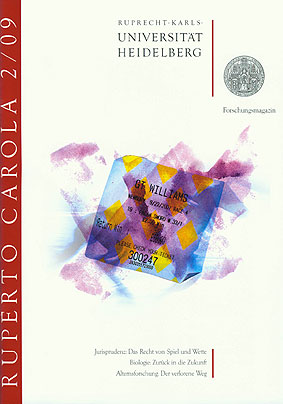Ruperto Carola 2/09: Gambling - Rights and Laws
Exciting news from law, biology, astrophysics, medicine, gerontology and economics in Heidelberg University’s Research Magazine

SLaws concerning gambling have existed since antiquity, as Götz Schulze shows in his title article in Heidelberg University’s research magazine Ruperto Carola 2/09. The social practice of gambling and betting is ancient – and the laws regulating these pleasures are nearly as ancient. Likewise, the knowledge that games of chance are dangerous as well as enjoyable has been with us through the ages. Schulze examines means of protecting gamblers from their passion. This protection is regulated in Germany by agreements among the various federal states. “In the past, the German government has not fulfilled this task sufficiently,” writes Schulze, a legal scholar, who examines the German Federal Constitutional Court’s 2006 decision regarding the states’ gaming monopolies. Is this newly created regulation in accordance with European Community Law?
Further topics included in this issue present exciting news from biology, astrophysics, medicine, gerontology and economics.
Marcus Koch discusses the ways that genes enable us to look into plants’ pasts and predict their future development. It is interesting to know what the future may hold, and not only in times of change. Whether and how climatic change will threaten life on earth, and whether plants will be able to adjust to the changed climatic conditions and survive is the focus of a new subfield within biology, phylogeography. Koch shows how modern molecular methods make it possible for scientists to reconstruct the evolutionary history of species, and groups of species, and to draw conclusions based on past observations in order to see whether or not plants have a future.
As Ralf Klessen reminds us in his article, the stars have fascinated humans for eons. While we used to believe that the “fixed stars” were unmovable, eternally existing objects, modern research methods give a more dynamic picture. Stars are part of a cosmic circle of life – they are born, and they perish. Their cradles in the Milky Way are dark clouds of gas and dust that collapse under their own weight. The birth of a star is a dramatic event that raises a host of unresolved questions. Researchers at Heidelberg University’s Centre for Astronomy use computer simulations to examine the physical processes that create stars, including our sun.
In the following piece, Andreas Fischer and Hellmut Augustin describe a fatal affair, in which cancer cells begin an unfortunate liaison with blood vessels. This relationship can, however, be put to therapeutic use. Anti-angiogenesis, the destruction of tumours via medications that prevent the additional growth of blood vessels in malignant tumours, which has been doubted for decades, has now established itself as an additional method of cancer treatment. Improvements in our understanding of the processes by which blood vessels regenerate gives hope for further new therapies, not just for treating cancer, but also for preventing heart attacks or strokes.
As soon as we are able to run, movement defines our lives. Internal and external signposts keep us on the right track and allow us to reach our destination, or find our way back home. As we age, in addition to losses in cognitive function, we also lose an ability that we will have taken for granted for decades. Hens-Werner Wahl and Noam Shoval describe modern navigational systems that make it possible to track the elderly’s movements outside the home. This can increase the security of both the seniors and their relatives. Characteristic changes in seniors’ mobility patterns can be first indicators of alarming cognitive losses, and give us a chance to recognize and treat dementia in its early stages.
“If the fundamental data are incapable of explaining prices, then we are always dealing with a speculative bubble.” Thus economists explain a phenomenon that predates globalisation, modern finance markets and hedge funds. But, as Jörg Oechssler asserts in his contribution, this phenomenon is insufficient to explain extreme and seemingly irrational price movements. Scientists and students at Heidelberg University have shown which necessary “ingredients,” even in simple and transparent markets, could plausibly create a speculative bubble – an insightful experiment with uncannily human traits.
“Cold, colder and coldest” is the theme of Sandro Wimberger and Tobias Paul’s short essay about the fundamental quantum properties of new technological applications.
The Heidelberg Research Magazine is published by Universitätsverlag Winter, Heidelberg. Each issue costs 5 euros plus shipping. A supporter’s subscription can be purchased for 30 euros from: Universität Heidelberg, Communications und Marketing, Press Office, Postfach 10 57 60, 69047 Heidelberg. Free sample copies of older issues can be found in the foyer of the university’s Old Aula. Further information and full-text copies of older issues can be accessed online at http://www.uni-heidelberg.de/presse/publikat.html
Further Information:
Heidelberg University
Communications and Marketing
Tel.: 06221 54-2311
Fax: 06221 54-2317
presse@rektorat.uni-heidelberg.de

